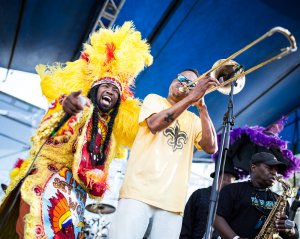Inspired by Decline: Old Quarter Feeds Creativity
If “the seed must die to generate new life,” it was the post Civil War demise of the old Creole society in the New Orleans French Quarter that gave rise to a world of romantic reminiscences about it. Those enigmatic Creoles– be they private, penurious, prideful in their poverty–left their indelible mark on the world they built. The sprit of what went before absorbed and co-opted those who came afterwards, those who inherited the remnants of the kingdom. Living with the dense, semi-fortified streetscape, a world of light and shadow known for withholding some of her favors, they came to grips with the sense that something about the place and the people was elusive. Thus was born the New Orleans fiction of George Washington Cable and Lafcadio Hearn, of Grace King and Kate Chopin, in the waning years of the 19th century. As historian S. Fred Starr has written of Hearn especially, they “invented New Orleans.” And if Creoles resented being probed and analyzed, ridiculed and fictionalized, perhaps it was because they were the un-self-conscious, uninvented, genuine article.
Time wore on and time wore down the neighborhood. No longer a place of grace and wealth, it became a place for the displaced, for the poor, the immigrant who lent his flavors to the heady mix of place and people. It all came together at the Old French Market, where the scenes and scents of vital life swirled into a piece with historic precedent. This was a place for those who were comfortable with a dense urbanism, risk-takers who found a little or a lot of dirt and disorder, clutter and confusion somewhat acceptable.
Nineteen hundred was the winter of existence in the life of the Quarter. Its people were as poor and as worn as its streets and its buildings. As the one-eyed, night-watching Hearn had recounted, the populace lived in warrens, washed food and body in courtyard fountains, and worked from dawn to sunset. But if the seeds of growth were buried, the earth was fertile. Photographers arriving in 1920 were as astounded to see it as archaeologists finding treasure. With careful lens they captured the Quarter as it emerged unretouched from its postwar decline. Scenes captured by photographers Tebbs and Knell of the 1920s presented a stark contrast to the polished views commissioned by the city in the work of Lilienthal fifty years earlier.
Writers and painters followed. The starving artist could find in the Quarter an inexpensive room with a picturesque view of rooftops looking like Left Bank Paris, piano music drifting upward, and kindred spirits, human and bottled, at every neighborhood corner. If it is a natural part of an artist to find virtue in decay and a sultry atmosphere, saints abounded. William Faulkner, writing from a Pirate’s Alley flat in 1925, composed this take on Jackson Square at nightfall:
“He opened the street door. Twilight ran in like a quiet, violet dog, and nursing his bottle, he peered out across an undimensional feathered square across stenciled palms and Andrew Jackson’s childish effigy….” – (Mosquitos, 1927).
Writers of the Twenties and Thirties flocked to the Quarter. Along with Faulkner, Sherwood Anderson, Ernest Hemingway, Thornton Wilder, Roark Bradford, Tennessee Williams, Truman Capote, Lillian Hellman, Lyle Saxon, and Hamilton Basso were among those who found their way to the Old Square of New Orleans for inspiration. They found it in peeling paint and shadowy, overgrown courtyards, in a heavily Black and ethnic population, in an environment where people lived out customs, found parts of day-to-day survival on the stoops of crumbing cottages, and valued old things, because in them, one found comfort.
Peeling paint and timeworn surfaces have given way to fun, food and entertainment. But the Quarter’s atmosphere of creativity has endured for residents and visitors. Try your luck with inspiration in a quiet corner. You just might be surprised to find it.
Sally Reeves is a noted writer and historian who co-authored the award winning series New Orleans Architecture. She also has written Jacques-Felix Lelièvre’s New Louisiana Gardener and Grand Isle of the Gulf – An Early History. She is currently working on a social and architectural history of New Orleans public markets and on a book on the contributions of free persons of color to vernacular architecture in antebellum New Orleans.





